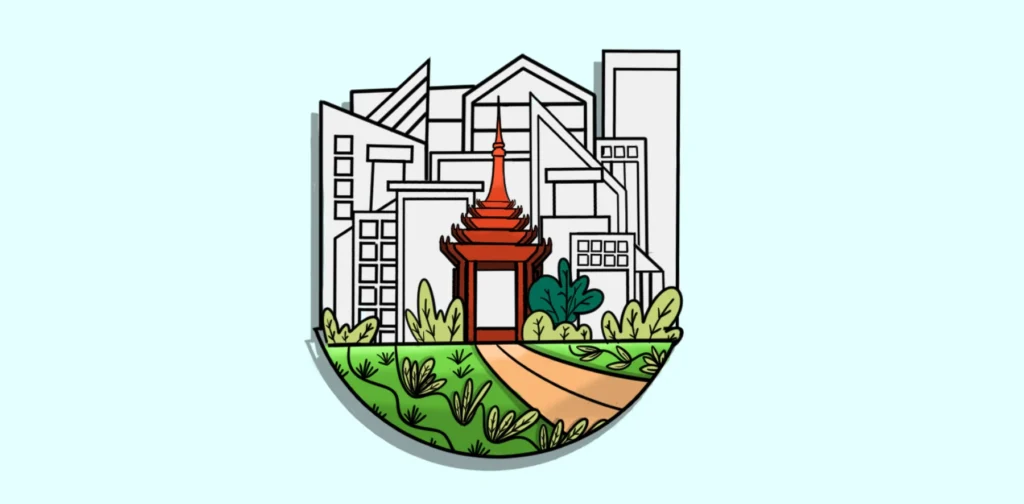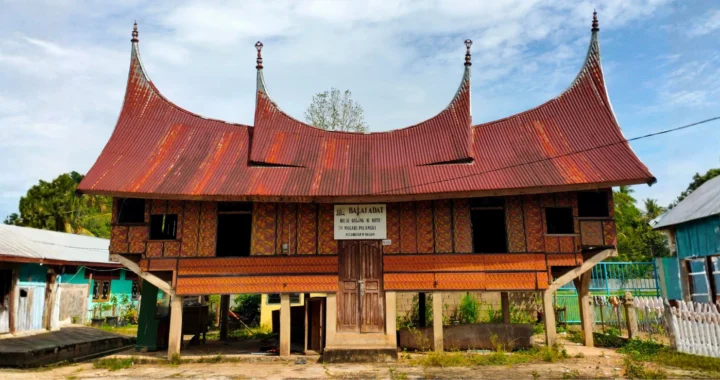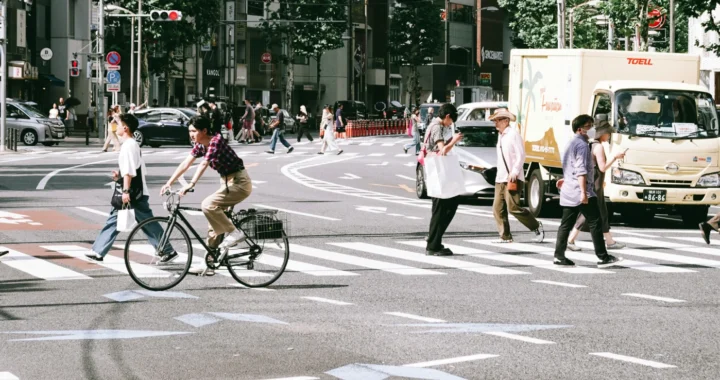Amending Phnom Penh’s Green Spaces: Should we go small with pocket parks?

Illustration: Irhan Prabasukma.
Phnom Penh, Cambodia’s capital, has undergone rapid urbanization, especially in the last three decades. The city’s growth trajectory continued with the development of thoughtfully planned gardens throughout the French colonization until the present, resulting in 87 public spaces, many of which incorporate green areas. However, with a population approaching four million, the development of Phnom Penh’s green spaces must evolve to address space deficit and distribution disparity. Currently, given the city’s compact urban form, pocket parks or small-scale urban parks present a potential alternative for urban green spaces.
Phnom Penh’s Urban Revitalization
The Cambodian government has prioritized urban greening, evident in policies such as the Phnom Penh Green City Strategic Plan (2017-2026) and initiatives to develop suburban parks. To encourage community involvement, design competitions have been organized, and existing parks have been upgraded with amenities like playgrounds and outdoor gyms.
However, the focus has been on park improvement rather than expansion, leading to a shortage of green spaces, especially in densely populated areas. While new parks, such as the one beneath the Steung Mean Chey Sky-Bridge and those in suburban gated communities have been created, residents still have to compete for limited access.
The growing population and urban expansion have strained green space resources. Furthermore, a significant disparity exists in green space distribution, with nearly 75% concentrated within the central grid-zoned district compared to the outer areas.
To address this gap, private developers have begun transforming underutilized spaces into green areas. Projects like Urban Village and Odom Garden showcase the potential of converting industrial and residential buildings into green hubs. Urban infill, renewal, and revitalization into workspaces and green coffee shops have also become a trend, offering nearby green areas and seating for local residents. Nevertheless, the majority of these initiatives are privately owned, limiting public access and affordability.
Phnom Penh requires more diverse green spaces than solely relying on existing parks and private initiatives. Given the city’s dense urban fabric, acquiring large plots of land in the city center is practically challenging. To address this, the government should strategically implement small urban green infill and renewal projects, creating a network of scattered pocket parks.
Pocket Parks: Definition and Challenges
Pocket parks, also known as green pockets, community parks, or mini-parks have no strict size standard, typically ranging from as small as 0.9 square meters. Pocket parks serve diverse community needs beyond greenery. Recognized by urban environmentalists as a tool to mitigate urban heat islands, contribute to water-sensitive urban design, and enhance biodiversity, pocket parks are increasingly integrated into dense urban areas for improved sustainability.
However, creating pocket parks in Phnom Penh is hindered by a combination of site limitations, design complexities, and operational difficulties. As a relatively new concept, pocket parks face challenges due to the absence of strict enforcement of construction standards and building codes. Identifying suitable locations is difficult because many of Phnom Penh’s public spaces are occupied by the informal economy.
Furthermore, without careful design and community input, pocket parks risk prioritizing aesthetics over functionality and local needs. The scarcity of landscape architects experienced in small-scale park design further complicates the process. Designing pocket parks is time-consuming and costly compared to larger parks due to the unique needs of each location. Additionally, vandalism, security concerns, and ongoing operational costs pose significant challenges.
Sewing Phnom Penh’s Green Spaces
Despite the challenges, Phnom Penh can effectively implement pocket parks through a multifaceted approach. First, a comprehensive citywide assessment should identify potential locations, including vacant lots, rooftops, and even building facades. Second, the government should establish a dedicated task force to develop a comprehensive policy framework with guidelines, building standards, zoning regulations, and an interactive map for green space development. Third, creating pocket parks requires collaboration among landscape architects, urban planners, and community members. A bottom-up approach with various participatory tools can ensure community ownership, engagement, and functionality of spaces.
While design and planning are crucial for pocket park development, ensuring their long-term sustainability is equally essential. Financial sustainability can be achieved through dedicated funding mechanisms for development and maintenance, supplemented by volunteer involvement, cost-effective design, public-private partnerships, or fundraising. Additionally, a robust monitoring and evaluation system, tracking user satisfaction and environmental benefits, will inform future park development and management.
The future of Phnom Penh’s urban landscape holds great promise with the emerging focus on pocket parks. Successful implementation of these green spaces will depend on comprehensive planning, collaborative efforts, and sustained investment in design, maintenance, and community engagement.
Editor: Nazalea Kusuma

Join Green Network Asia Membership
If you find this content useful, support Green Network Asia’s movement to create positive impact for people and the planet through public education and multi-stakeholder advocacy on sustainability-related issues and sustainable development. Get exclusive benefits for personal and professional development as well as for organizational capacity development.
Become a Member Now
Pisith Hun
Pisith is an architect and adjunct lecturer in Urban Planning at Paragon International University and the Royal University of Fine Arts in Cambodia. He holds an MSc in Urban and Regional Planning from the University of Queensland, Australia.


 Understanding the Dark Side of Artificial Intelligence
Understanding the Dark Side of Artificial Intelligence  Attempting Data Center Circularity Through Waste Heat Recovery
Attempting Data Center Circularity Through Waste Heat Recovery  Indigenous Knowledge and Art as Integral Instruments for Disaster Risk Reduction
Indigenous Knowledge and Art as Integral Instruments for Disaster Risk Reduction  Strengthening Societal Resilience in the Age of Disruptions
Strengthening Societal Resilience in the Age of Disruptions  Building Strategic Approach to Support Urban Health for All
Building Strategic Approach to Support Urban Health for All  Understanding and Addressing Multiple Dimensions of Child Deprivation
Understanding and Addressing Multiple Dimensions of Child Deprivation